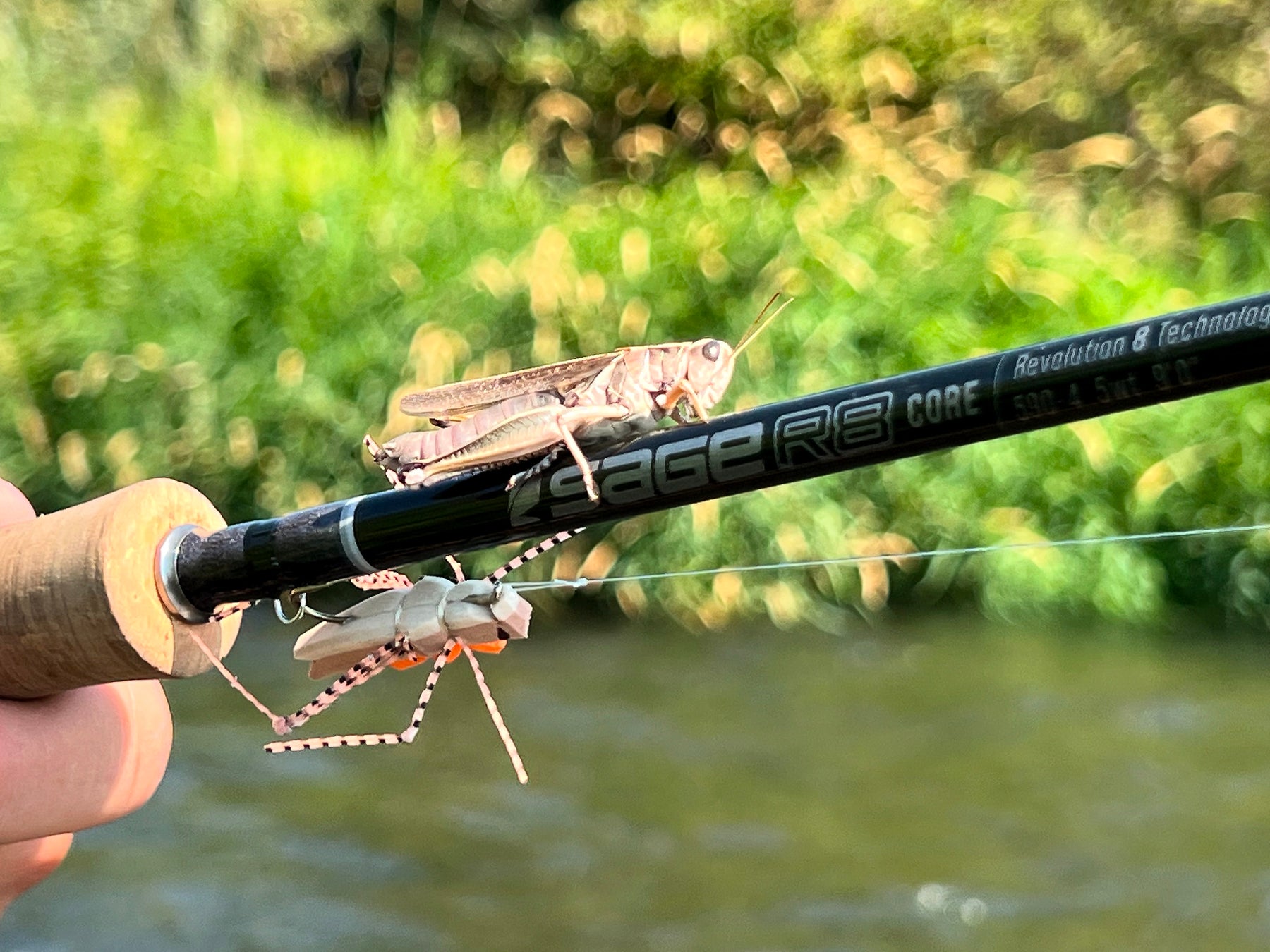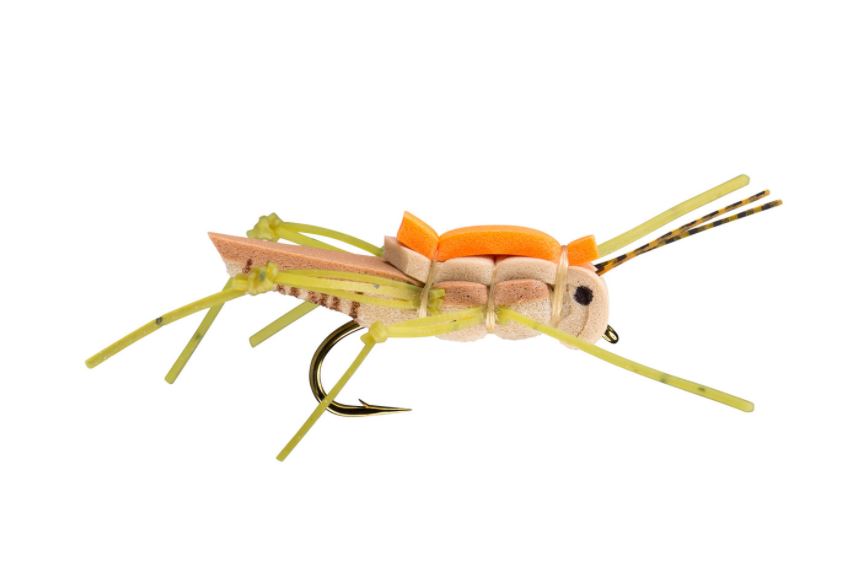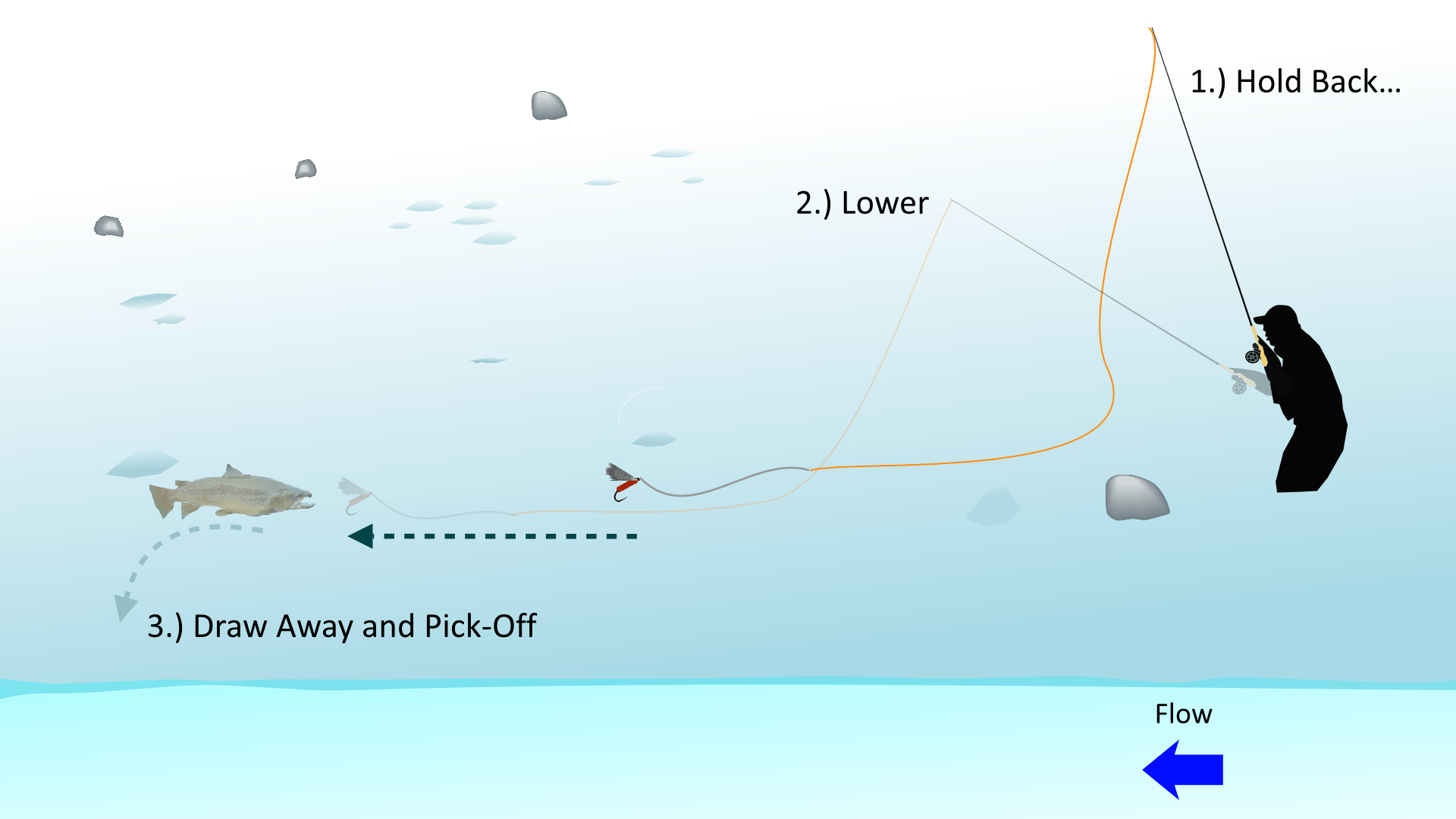CALL NOW (509)933-2300
CALL NOW (509)933-2300

My favorite time of year is hopper time. I just love the technical nature of splashing, twitching, and scooting these leggy bugs along the bank to generate strikes. It's so natural! Trout can be fooled so many different ways using a hopper from a perfect splat-down landing to a wiggly jig, tumbling off the grass, or skip casting back into a shady pocket. You get to make your own action with hoppers!
This video does a pretty good job of outlining my ten best tips for fishing grasshoppers.
This is my most effective cast. How many times do you throw what looks like the perfect cast... an inch from the bank, but within 2 seconds its dragging out. Or you attempt to mend it and suddently you're 18" off the shore. Out of the game. Learn to do this, deliver the fly with velocity and learn to gently pivot your slack the appropriate direction. Use this cast to probe into the toughest spots and because we deliver with line speed the wind won't affect the fly's ability to hit the target. If you practice this, you'll learn to pivot slack left, right, neutral, and the fly will splat down and instantly begin a drag free drift. You'll draw fish out of those shoreline spots that many think are impossible.
Your fly will wind up in the grass. No doubt about it. For me, this is intentional. When I see luscious green grass with some dark water underneath it gives me goosebumps. Something big might be living under there. I say "luscious green grass" because that is far more forgiving than fully developed yellow seedheads. These are snaggy and unforgiving to the fly and line. Nice green soft blads are a great landing zone for your fly, if you have a good strategy to gently walk it into the water so the fly stays be shore. If you use the flex in your rod, the tip, to try and coax the fly into the water you'll likely wind up with a fly shooting halfway back to you or at best a few feet from the shore. Inversely, if you put your rod tip down low the current might draw the fly off the grass into the water. It looks so real! You'll see this in the video. Sometimes you'll need to strip the line a bit, just keep the rod tip down and sometimes you'll even bend the blade of grass down to water's edge before the fly releases. Do this as your default each time you hit the grass, by day's end you'll find some big trout.
Get hoppers. Don't just fish chubby's all the time. Yes, they work. Typically when the trout are hungry, unpressured, and aggressive. In this case, you'll catch fish on anything so it's not really an advantage other than you can see your fly and it floats like a cork. Nice features, but part of the fun of hopper fishing is using a bug that looks rea! I've included a few of my favorite hoppers. Make sure to have a mix of foam and fiber. My overall preference is foam, the way it bobs around is very natural, but I've seen times that the lighting has them preferring a fiber bug 10x over foam.
RIO's Morrish Hopper - Tan, Pink, Yellow are all my go-to's.

RIO's Juicy Hopper - All colors. The green is the most real looking hopper we sell!
Dave's Hopper by Fulling Mill - the ol' standard. This fly casts like a rocket and I can put it into places that the foam hoppers can't get to as they are much more wind resistant. This fly also fishes very well soggy! Sometimes they favor it an inch under water. Skip the floatant and try this if you are getting short strikes.
Practice this! It's properly called an "Underslung Loop" and a deadly way to skip or scoot flies back into places that others think impossible. And you can do it with control, you can learn to set this cast up so that if you muff the shot, your fly simply piles up well short of the tree or cut bank you're firing at. This is a critical tool IMO if you want to become a top tier angler for any and all species.

I stole this image off of the flyfishingforum.com - hope they aren't mad, but it was the best diagram I could find. The fly will often skip on it's way in and settle down with a nice landing! Really useful tool for fishing structure. I use this for bass, trout, tarpon, snook.
A Non-slip mono loop is critical. Learn it. More action, better hookups. Nuff said.
Hoppers really need to be delivered with good velocity under control, so the "overpowered curve" is preferred versus the underpowered reach casts. It's more accurate. I only demonstrated on my strong side as that is where I happened to be fishing, but you can do it kack-handed or off-handed as well.
If this is new to you or simply foreign, just remember this. Stop crisp on your hopper casts, start there with a firm high 10 o'clock stop. That's it. You do this and at the same time understand that manipulation of the slack line can be used to your advantage and your intuition will do the rest.
Use what ya got, and move up the food chain as your commitment to fly fishing grows deeper. When I was a broke 18 year old I still remember ordering an Orvis Clearwater 8'6" 5 weight out of their paper catalog. $149 for the rod, reel, and line. It was a nicer rod than I ever thought I would own! I was broke financially, but rich with fly fishing experiences. As time has gong by I appreciate the value of fine rods that are light, crisp, clean, responsive, and grow with you. Just buy the best you can afford when it comes to models and brands.
Size wise, the BEST rods for most mid-sized waters will be 8'6" 4-5 weight fast action rods. A modern WF Floating line will do it, and there are some lines that are designed specifically for casting big dry flies. The RIO Bankrobber is a heck of a line for your 5 weight.
Sage R8 590-4 - 9' 5 Weight (the rod being cast in all of the tips)

Beulah G2 Platinum 8'8" 4 Weight Rod (love this rod) I would have love to fished it in the video but I prefer to demo using a bring orange line. It's very fast action and punches a hopper in TIGHT to the toughest spots. It throws and underslung loop as though you are shooting a paint ball gun. The fly just rifles into the bank like a projectile.
 RIO BankRobber Fly Line (they make this in 5/6 weight) Super line for punching into the bank.
RIO BankRobber Fly Line (they make this in 5/6 weight) Super line for punching into the bank.
Hoppers need to fish immediately after they hit. Big mends or line feeding just puts fish off. Especially big ol' smart fish that have played the game a while. I stole this image off of fishingdiscoveries.com - go check it out.

There are a ton of leaders that might be useful for hoppers. It needs to be stiff enough that a leggy bug won't spin it up and make a tangle, strong enough to deal with a few impacts with sticks and grass, but light enough to fool the trout. It needs to be short enough for effective accurate casting.
I typically go with a 7.5' 3X Mono leader, then tip with a short piece of Fluorocarbon for picky fish or extremely clear water. The little chunk of Fluro sinks pretty fast, and if you use too much Fluorocarbon it will sink your fly and make mending and twitching a challenge. A short piece spliced in with a Triple Surgeon's Knot works great.
Movement will induce strikes... when done correctly. When done incorrectly... you could fish half a season with no strike haha. Think about the rings or waves you are making. Try to make them rounded, not a V-shaped ripple. Rattle the rod tip, make oscillations down the line, and PRACTICE. Get good and giving your fly the tiniest nudges. Just enough to wiggle the legs and make a small wave ring. Don't over do it!
Use movement in place of traditional mends. You can do a good job of hiding mends with a nudge on the fly. It's a crucial technique.
Comments
Leave a comment